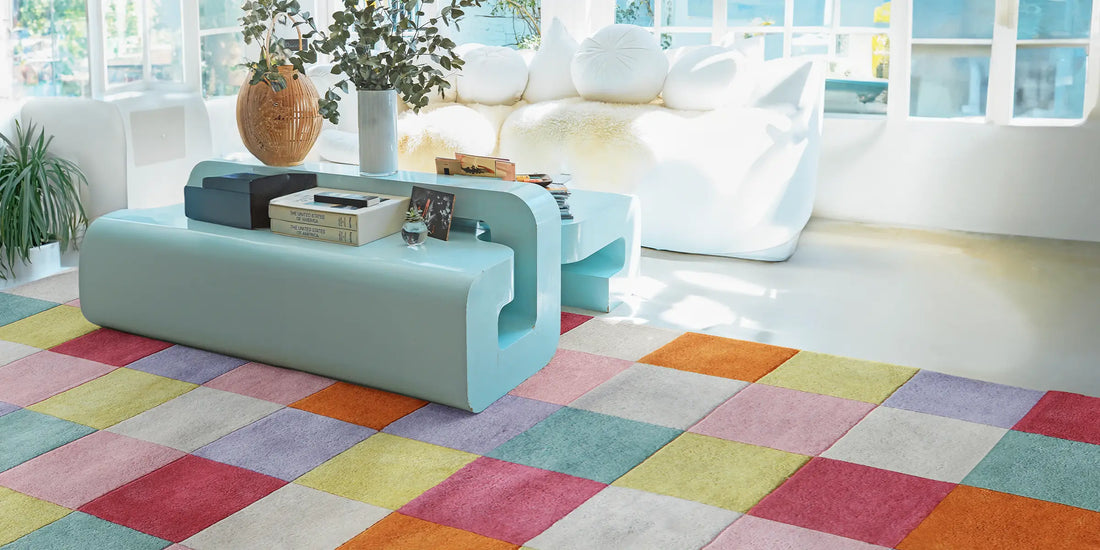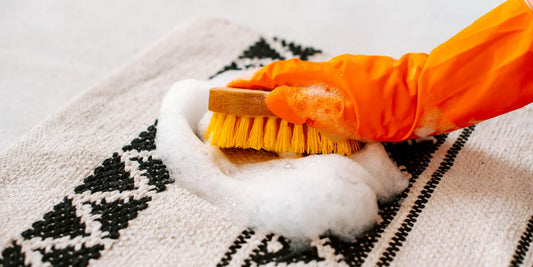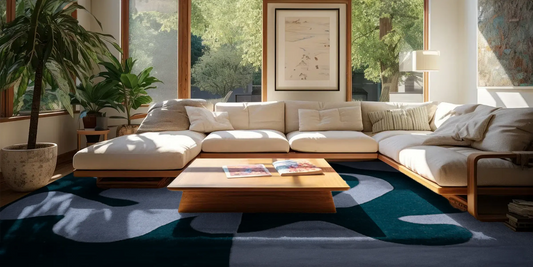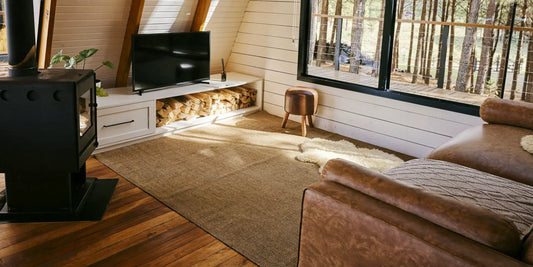How can you tell if a rug is really good or not?

Stepping onto a fine rug is like walking into a world of luxury and heritage; it's an experience that touches all senses. The quest to define and distinguish a high-quality rug is akin to uncovering the secrets of a masterful piece of art. The texture, the colors, the weave—all come together to tell a story of craftsmanship and style.
Enter JUBI, a brand synonymous with unique and ethically-made decor. Cassie and her Grandma Lina share a passion for design, which led them to create JUBI. It stands as a beacon of quality in a sea of mass-produced items.
Rugs from JUBI are not just floor coverings; they are curated expressions of artistry and commitment to sustainability.
For discerning decorators and homeowners alike, understanding what sets a high-quality rug apart is essential. It's about recognizing the subtle interplay of materials, construction, and creativity that elevates a rug from merely functional to truly exceptional.
With this knowledge, connoisseurs can make informed choices that reflect their values and aesthetic, ensuring their spaces are graced with pieces that will be cherished for generations.
1. How Do Material and Construction Define the Quality of a Rug?
When looking for a high-quality rug, the materials used and the way it's made are key factors that determine its beauty and how long it will last. Choosing natural fibers like wool or silk instead of synthetic materials can make a big difference in how the rug looks and feels.
1.1. Durability and Soil-Hiding Properties

The key to a rug staying beautiful for years lies in what it's made of. Here's why wool is often considered the best choice:
-
Naturally Resilient: Wool fibers have a natural crimp that acts like a spring, allowing them to bounce back quickly after being compressed by furniture or footsteps. This means wool rugs can handle lots of foot traffic without getting flattened.
-
Stain Resistance: The outer layer of wool fibers repels water and stains, making it easier to clean up spills before they soak in.
-
Hides Dirt: The way wool fibers are structured helps hide dirt deep within the rug until it's time for cleaning. This means wool rugs can look cleaner for longer periods.
- Ages Well: Unlike some synthetic materials that might wear down or show aging through fading, wool rugs develop a patina over time that enhances their character.
Another luxurious option is silk, which is known for its shiny appearance and smooth texture. It's often used together with wool to add an extra touch of elegance to the rug. While silk can be more delicate compared to wool, it adds to the overall beauty of the rug.
On the other hand, there are synthetic options like nylon or polyester that offer their own advantages:
- Affordable: Synthetic rugs usually cost less than natural fiber rugs.
- Wide Range of Colors: Advanced dyeing techniques make it possible for synthetic rugs to have vibrant colors and intricate patterns.
- Easy to Clean: Synthetic fibers don't absorb liquids as much as natural fibers do, so spills can be cleaned up more easily.
But it's important to note that these man-made fibers may not have the same long-lasting durability and environmentally-friendly qualities as natural fibers do.
1.2. The Art of Hand-Knotting

When it comes to how rugs are made, hand-knotting is considered the pinnacle of craftsmanship. Skilled artisans spend hours tying each knot by hand, resulting in rugs that are not only incredibly durable but also one-of-a-kind pieces with their own stories to tell.
This seamless transition into the next section will explore how vibrant colors and fine knot count contribute to defining high-quality rugs.
1.2. Vibrant Colors and Fine Knot Count
When you look at a high-quality rug, two things immediately stand out: vibrant colors and a fine knot count. These elements not only make the rug beautiful but also tell a story about the skill that went into making it.
Vibrant Colors
Natural fibers like wool and silk are known for their ability to hold dye well. This means that rugs made from these materials can have rich, saturated colors that stay bright for a long time. When you see a rug with vibrant hues, it's a sign that quality materials were used and expert dyeing techniques were employed.
Fine Knot Count
The number of knots per square inch (KPSI) is an important factor in determining how intricate a rug's design is. Rugs with a higher KPSI tend to have more detailed patterns because each small knot adds to the overall precision of the image.
While wool and silk are popular choices for their luxurious feel and lasting beauty, there are also synthetic options available. These may be cheaper and offer features like better stain resistance, but they can impact the rug's performance and durability in ways that natural fibers don't.
Whether it's the softness of wool or the shine of silk, the material used in a rug affects not just how it looks but also how well it holds up over time. By understanding how material and construction come together in vibrant colors and fine knot counts, you'll be able to truly appreciate what makes a rug exceptional.
2. What Sets Handmade Oriental and Persian Rugs Apart in Excellence?
2.1. Color Variations and Absence of Fringes
When exploring the beauty of handmade rugs, especially those from Oriental and Persian origins, you can't help but notice their vibrant colors. These special rugs are known for:
- Richness in Color: Unlike factory-made rugs, handmade Oriental and Persian rugs often display a richness in color that comes from using natural dyes and traditional dyeing methods. The colors aren't flat or uniform; instead, they have depth and nuance, with subtle variations that make each rug unique.
- Deliberate Shade Differences: Craftsmen intentionally include subtle shade differences, called 'abrash', within the same color group to add depth and texture. These differences can be caused by variations in wool batches or dye lots and are cherished as signs of a rug being handmade.
- Symbolic Meanings in Colors: Colors used in these rugs often carry symbolic meanings, such as red representing happiness or courage, blue symbolizing tranquility or the afterlife, and green signifying paradise or sacredness.
Handmade Oriental and Persian rugs also set themselves apart by not having sewn-on fringes—a common feature in many mass-produced rugs. Here's why this is significant:
- Intrinsic to the Loom: In top-quality hand woven rugs, fringes are an integral part of the loom's structure as they come directly from the warp strings. They aren't added later through sewing but rather extend naturally from the warp threads that run along the entire length of the rug.
- Signs of Authenticity: The presence or absence of attached fringes can be an indication of authenticity. In genuine pieces, these fringes are usually treated with care to prevent them from unraveling while maintaining the rug's overall design.
The presence or treatment of fringes on high-end Oriental and Persian rugs speaks volumes about their authenticity and craftsmanship. When examining these rugs, one can truly admire how every aspect—from the colors to the final details—showcases a commitment to creating something truly exceptional.
Artisans put their expertise and passion into each knot, ensuring that their creations stand out as examples of superb craftsmanship. It is through these intricate elements that knowledgeable collectors recognize handmade Oriental and Persian rugs as valuable works of art deserving of appreciation and investment.
These rugs are not just beautiful objects; they carry with them a sense of tradition, a connection to history, and the legacy of skilled craftsmen who have poured their creativity into every single thread.
2.2. Backside Characteristics and Knot Density
Handmade rugs, especially Oriental and Persian rugs, are more than just floor coverings - they are works of art. Each rug tells a story with its detailed designs and exceptional craftsmanship.
To fully understand and appreciate these incredible creations, it's important to look beyond the surface and examine the backside where their true quality is often hidden.
1. Irregularities on Reverse Side
When you turn over an Oriental or Persian rug, you may notice subtle irregularities on the back. These slight variations are actually a sign that the rug was made by hand, rather than by a machine. Unlike mass-produced rugs that are perfectly uniform, these handmade treasures have unique imperfections that show the touch of the artisan.
Each flaw in the rug reveals the weaver's individual style and technique, making it truly one-of-a-kind.
2. Knot Density
Another key indicator of quality in handmade rugs is knot density, which refers to the number of knots per square inch (KPI). The higher the knot density, the more intricate and detailed the pattern of the rug.
Think of knot density as the resolution of a picture - the higher it is, the clearer and sharper the image will be.
This density not only showcases the skill of the weaver but also contributes to the overall strength and durability of the rug.
Understanding these factors is essential for rug enthusiasts who want to distinguish between authentic handmade rugs and mass-produced imitations. While colors and fringes may initially catch your eye, a closer examination of knot density and backside characteristics will reveal the true beauty and value of fine Oriental and Persian rugs.
Remember: True beauty lies beneath the surface.
2.3. Embracing a Subtle Pile: The Significance of Thin Thickness
When you explore the world of handmade rugs, especially those from Oriental and Persian origins, you'll notice that many of them have a thin pile thickness. This is not a coincidence; there are several important reasons behind this choice:
1. Intricate Patterns
A thin pile allows for tighter weaving and more detailed designs. Artisans can create incredibly intricate patterns that would be impossible to achieve with a thicker pile.
2. Refined Look and Feel
Thin-pile rugs have an elegant appearance. They lie flat on the floor, creating a sleek profile that enhances the overall look of any room.
3. Unique Pieces
Each handmade rug is unique, but thin piles often indicate that an individual artisan has dedicated significant time and effort to crafting the piece. This personal touch adds personality and flair to the rug, making it more than just a functional item.
4. Color Shades
High-quality handmade rugs are known for their subtle color variations, which add depth and richness to the design. In thin-pile rugs, these color shades are even more pronounced, allowing the hues to interact dynamically with light and shadow.
5. Sewn-on Fringes
Unlike machine-made rugs, top-notch Oriental and Persian rugs may have fringes that are an extension of the warp threads instead of being sewn on separately after production. This small detail is best appreciated when the rug has a slimmer profile.
By understanding these characteristics, you can easily tell the difference between handmade and machine-made rugs. Handmade rugs are not just ordinary floor coverings; they are stories woven by skilled artisans, showcasing the beauty of traditional rug-making techniques in every thread and shade.
Now that you have a better grasp of how pile thickness affects handmade rugs, let's move on to the next section where we'll discuss how you can navigate the market to find authentic, high-quality rugs.
3. How Can Rug Dealers and Expert Recommendations Guide Your Market Navigation?
Selecting the perfect rug for your space involves more than just picking a design you love. It's crucial to ensure the quality matches the aesthetic appeal. This is where the expertise of rug dealers and recommendations from professionals become invaluable.
Trustworthy Rug Dealers
- Seek out reputable companies known for their commitment to quality and authenticity.
- A reputable rug dealer will have a wealth of knowledge about different rug types and can guide you toward a high-quality selection based on your preferences and needs.
- They should provide detailed information about the rug's origin, materials, construction method, and care instructions.
Expert Insights
- Connect with local rug cleaners or industry experts who understand the nuances of rug quality.
- These professionals often possess insights into which rugs withstand wear and cleaning processes best.
- They can also inform you about maintenance needs that could influence your choice, ensuring longevity for your chosen piece.
By engaging with knowledgeable dealers and professionals, you elevate your chances of finding a rug that is not only visually stunning but also embodies craftsmanship that will endure through time.
4. Understanding Different Rug Construction Types to Make Informed Choices
It's important to understand the different types of rug construction when choosing a high-quality rug. Each method has its own characteristics that affect how the rug looks, how long it lasts, and where it works best.
Hand-Knotted Rugs
- Traditional craftsmanship: Skilled artisans tie each knot by hand, creating intricate patterns.
- Built to last: Well-made hand-knotted rugs can stay beautiful for many years and even become family heirlooms.
-
Higher cost, higher quality: Because of the time and effort involved, these rugs are usually more expensive but are also seen as a mark of superior skill.
Flatweave Rugs
- No raised surface: These rugs are woven flat without any knots, making them perfect for areas with lots of foot traffic.
- Many styles to choose from: Flatweaves come in a wide range of patterns and designs, from traditional kilims to contemporary geometric prints.
-
Easy to clean: Without a pile to trap dirt, they can be quickly cleaned with a vacuum or a simple shake outside.
Tufted Rugs
-
Quick production: Yarn is punched through a backing material with a machine, making tufted rugs faster to create than hand-knotted ones.
-
Affordable comfort: They offer a soft feel underfoot at a more budget-friendly price point.
- Opportunity for creativity: This technique allows for different textures and design possibilities.
When you're thinking about buying a rug, it's also important to watch out for any hidden damage that may not be immediately visible. Some issues to look for include:
- Wear underneath the surface of the rug
- Previous repairs that aren't easily noticeable
- Weakness in the foundation due to age or damage from moths
Take the time to carefully inspect the rug before making a decision. Flip over the corners and look at the back to get a better idea of its condition and history. Pay attention to the fringe and edges where signs of wear often show up first.
If you're not familiar with these specific details, it can be helpful to seek advice from an expert or a trusted dealer who can point out any hidden flaws that might require expensive repairs in the future.
By understanding rug construction types and being aware of signs that indicate potential repair needs, you'll be able to choose a rug with confidence, knowing that it will bring long-lasting beauty and functionality to your home.
Conclusion
Selecting a rug is more than just picking a design; it's choosing a centerpiece that reflects your style and commitment to quality. An investment piece like a fine rug can transform any space, offering both beauty and longevity.
Explore the curated world of JUBI for an extraordinary collection that unites ethical craftsmanship with innovative design. Each rug in our selection is not just décor but a testament to the art of making and the stories each weave carries. Here are some steps to guide you:
- Assess Your Space: Consider the size, color scheme, and function of your room to determine the perfect rug.
- Consider Craftsmanship: Look for signs of expert weaving, material quality, and intricate patterns.
- Trust Reputable Sources: Ensure authenticity and quality by partnering with trustworthy dealers like JUBI.
Let the insights from this article be your compass as you navigate the vast sea of rugs available. When you're ready to enrich your home with texture, color, and timeless elegance, let JUBI be your harbor for high-quality rugs that resonate with style and sustainability.
Discover Your Perfect Rug at JUBI today, where every piece is more than decor—it's a celebration of enduring artisanship and ethical elegance.
FAQs (Frequently Asked Questions)
What is the significance of understanding the qualities that set high-quality rugs apart in the market?
Understanding the qualities that set high-quality rugs apart in the market is crucial for consumers to make informed purchasing decisions. It allows them to recognize the value and craftsmanship behind these rugs, ensuring long-term enjoyment and style impact.
How do premium materials, particularly wool, enhance the durability of rugs?
Premium materials like wool enhance the durability of rugs by providing natural resilience and strength. Wool is known for its ability to maintain its appearance over time and resist wear, making it a desirable choice for high-quality rug construction.
What role do vibrant colors play in showcasing the craftsmanship and attention to detail in high-quality rugs?
Vibrant colors play a significant role in showcasing the craftsmanship and attention to detail in high-quality rugs. They not only enhance the visual appeal of the rug but also demonstrate the intricate weaving techniques and artistic expertise employed in its creation.
How can readers differentiate between handmade and machine-made rugs, particularly Oriental and Persian designs?
Readers can differentiate between handmade and machine-made rugs by paying attention to specific characteristics found in Oriental and Persian rug traditions. These include irregularities on the reverse side, knot density, absence of fringes, and subtle pile thickness, all of which indicate handcrafted quality.
Why is it important to source rugs from trustworthy dealers and seek recommendations from local rug cleaners or experts?
Sourcing rugs from trustworthy dealers ensures that consumers are more likely to obtain genuine high-quality pieces and reliable information about the product. Seeking recommendations from local rug cleaners or experts allows consumers to gain valuable insights into the quality and maintenance needs of different rugs before making a purchase.
Why should readers educate themselves about various rug construction types before making a purchase?
Educating oneself about various rug construction types is essential for making informed choices that align with quality preferences and lifestyle requirements. This knowledge helps consumers understand the intricacies of rug construction techniques, identify potential concealed damage, and avoid costly repair needs.









